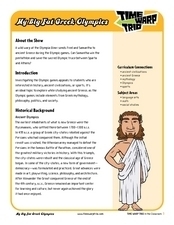Norwich University
Seven Man-Made Engineering Wonders of the Ancient World
Imagine precisely cutting and then moving a 120 ton boulder more than two miles without mechanical cutting tolls, skid loaders, or hydraulic cranes. Imagine carving a stone figure that includes a drainage system that permits rainwater to...
Texas Education Agency (TEA)
Roman Architecture
Design an office fit for the gods. Individuals view a PowerPoint presentation on Roman architecture, its key elements, and famous structures. In groups, they design an office building incorporating the elements of Roman architecture.
Partnership for Educating Colorado Students
Mayan Mathematics and Architecture
Take young scholars on a trip through history with this unit on the mathematics and architecture of the Mayan civilization. Starting with a introduction to their base twenty number system and the symbols they used, this eight-lesson unit...
Describing Egypt
Temple of Isis (Philae)
How did the Temple of Isis change throughout history? The resource discusses how architecture changed purposes over the time periods of the Pharaonic Era and the Greco-Roman Era. It gives a glimpse into what life was like and provides...
Describing Egypt
Ptah-Hotep and Akhet-Hotep Mastaba
Did you know that mastaba means bench in Arabic? Learn why a mastaba was so important to ancient Egyptian architecture. Middle and high schoolers alike stay entertained while reading a passage that describes the virtual tour of...
Describing Egypt
Horemheb - (18th Dynasty)
Who was Horemheb and why is his tomb so famous? An fascinating resource uses virtual reality tools and even comes equipped with the ability to use a VR headset. Learners view information panels to the side of the location to understand...
University of California
Bread and Circuses: Rome as a Site of Encounter
An intriguing lesson uses 12 Roman artifacts to explain Roman society and politics. Young historians view images of artifacts and learn how each one represents an aspect of Roman society. Academics also complete a hands-on activity to...
Time Warp Trio
My Big Fat Greek Olympics
The Olympic Games are indeed a significant and far-reaching cultural component in our international community today, but from where do they originate? Where do our traditions stem from, and how do we choose the sports that constitute...
Describing Egypt
Ty Mastaba
Many know the beauty of a pillared hall, but what makes those from ancient Egypt so breathtaking? An eye-catching resource takes viewers on a journey through the Ty Mastaba to discover the importance of pillars to architecture. They see...
BW Walch
Wondering About the New Seven (Man-Made) Wonders of the World
Who determines the Seven Wonders of the World, and what criteria is used to evaluate these locations? Discover the efforts to promote cultural diversity and preserve man-made monuments during the world's first-ever global vote in 2007 to...
Tutankhamun
Pharaohs, Pyramids and the World of the Gods
Your young historians will learn all about the pharaohs, pyramids, and gods of ancient Egypt with these informational text worksheets, each of which are accompanied by hands-on, follow-up activities.
Curated OER
The Early Ottoman Empire: 1281 - 1600s
Once one of the most powerful civilizations in the known world, the Ottoman Empire was all-encompassing and highly influencial in the Middle East. Enjoy maps that detail the Ottomans' rule, as well as pictures of relics and architecture...
American Museum of Natural History
Making a Field Journal
Trowels and brushes are certainly important tools for an archaeologist working on a dig. Perhaps more important, however, is the archaeologist's field journal. Christina Elson, an archaeologist working with the American Museum of Natural...
Other popular searches
- Roman Architecture
- Greek and Roman Architecture
- Roman & Greek Architecture
- Roman Architecture Project
- Ancient Architecture Rome
- Famous Roman Architecture
- Roman Greek Architecture
- Classical Roman Architecture
- Greco Roman Architecture
- Roman Architecture Basics
- Ancient Greece Architecture
- Roman Art and Architecture














